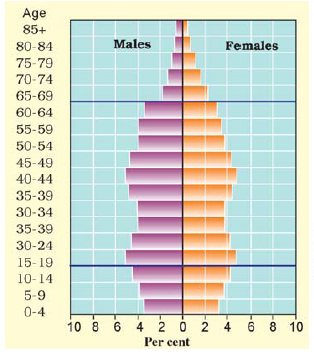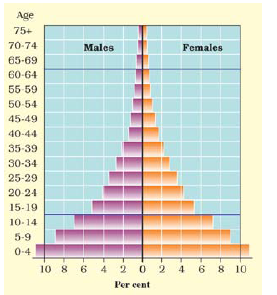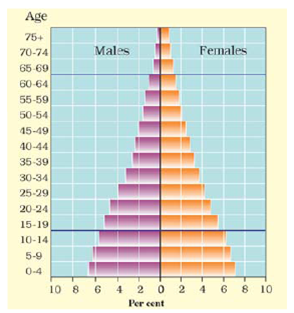Class 8 Geography Chapter 6 Human Resources Extra Questions
Class 8 Geography Chapter 6 Human Resources Extra Questions and Answers are provided here. These Extra Questions with solution are prepared by our team of expert teachers who are teaching in CBSE schools for years. Extra questions for Class 8 Geography Chapter 1 will help you to properly understand a particular concept of the chapter.
Human Resources Class 8 Geography Extra Questions and Answers
Very Short Answer Type Question
1. Which is the most populated continent of the world?
Answer: Asia
2. In which country is the city of Osaka located?
Answer: Osaka city is located in Japan.
3. Who are immigrants?
Answer: Immigrants are those who arrive in a country.
4. Who are Emigrants?
Answer: Emigrants are people who leave a country.
5. What is the average density of population in India?
Answer: Average density of population in India is 324 persons per square km.
6. What is life expectancy?
Answer: Life expectancy is the number of years that an average person can expect to live.
7. What is the average density of population in the whole world?
Answer: The average density of population in the whole world is 45 persons per square km.
8. What is known as the pattern of population distribution?
Answer: The way in which people are spread across the earth surface is known as the pattern of population distribution.
9. What is a population pyramid?
Answer: Population pyramid is a graphical presentation of the age, sex composition of a population.
10. What is meant by natural growth rate?
Answer: The difference between the birth rate and the death rate of a country is called the natural growth rate.
Short Type Answer Questions
1. Why is population growth slowing in United Kingdom?
Answer: In United Kingdom, population growth is slowing because of both low death and low birth rates.
2. In what respects do different human beings differ?
Answer: People vary greatly in their age, sex, literacy level, health condition, occupation and income level.
3. What is population density?
Answer: Population density is the number of people living in a unit area of the earth’s surface. It is normally expressed as per square km.
4. Why do people move from the rural to urban areas?
Or
Why do people migrate from rural to urban areas?
Answer: Within countries large number of people may move from the rural to urban areas in search of employment, education and health facilities.
5. How does climate affect the population distribution of an area?
Answer: People usually avoid extreme climates that are very hot or very cold like Sahara desert, polar regions of Russia, Canada and Antarctica.
6. What does the shape of a population pyramid of Japan indicate?
Or
Describe the population pyramid of Japan.
Answer: In countries like Japan, low birth rates make the pyramid narrow at the base. Decreased death rates allow numbers of people to reach old age.

7. The world population has grown very rapidly. Why?
Answer: The main reason for this growth was that with better food supplies and medicine, deaths were reducing, while the number of births still remained fairly high.
8. Human resources are not equally distributed over the world. Why?
Answer: Human resources like other resources are not equally distributed over the world. They differ in their educational levels, age and sex. Their numbers and characteristics also keep changing.
9. What is the general trend of international migrations? Why?
Answer: The general trend of international migrations is from the less developed nations to the more developed nations in search of better employment opportunities.
10. Why are people considered a resource?
Answer: Nature’s bounty becomes significant only when people find it useful. It is people with their demands and abilities that turn them into ‘resources’. Hence, human resource is the ultimate resource.
11. What is an age-sex pyramid?
Answer: A population pyramid, also called an “age-sex pyramid”, is a graphical illustration that shows the distribution of various age groups in a population, which forms the shape of a pyramid when the population is growing.
12. How crowded a country is, has little to do with its level of economic development. Explain with help of example.
Answer: How crowded a country is, has little to do with its level of economic development. For example, both Bangladesh and Japan are very densely populated but Japan is far more economically developed than Bangladesh.
13. What are the factors affecting population change?
Or
What are the main causes of population change explain in brief?
Or
What are the main elements of population change?
Or
What are the main components of population change?
Answer: The major factors affecting population are birth, death and migration. Birth rate is the number of live births per 1,000 people. Death rate is the number of deaths per 1,000 people. Migration is the movement of people in and out of an area.
14. Why some countries like Kenya have high population growth rates?
Answer: Some countries like Kenya have high population growth rates. They had both high birth rates and death rates. Now, with improving health care, death rates have fallen, but birth rates still remain high leading to high growth rates.
15. What is meant by population composition?
Answer: Population composition refers to the structure of the population.
The composition of population helps us to know how many are males or females, which age group they belong to, how educated they are and what type of occupations they are employed in, what their income levels and health conditions are.
Long Type Answer Questions
1. Why did world population rise from 1800 onwards?
Or
What was the main cause of population explosion?
Or
What has caused the population explosion?
Answer: In 1820, the world’s population reached one billion. A hundred and fifty years later, in the early 1970s, the world’s population reached 3 billion. This is often called population explosion. In 1999, less than 30 years later, the population doubled to 6 billion. The main reason for this growth was that with better food supplies and medicine, deaths were reducing, while the number of births still remained fairly high.
2. ‘Until the 1800s, the world’s population grew steadily but slowly.’ Why?
Answer: For an extremely long period of human history, until the 1800s, the world’s population grew steadily but slowly. Large numbers of babies were born, but they died early too. This was as there were no proper health facilities. Sufficient food was not available for all the people. Farmers were not able to produce enough to meet the food requirements of all the people. As a result the total increase in population was very low.
3. Discuss the role of any two factors influencing population change.
Answer: Birth rate and death rate are the natural causes of population change. Birth rate is the number of live births per 1,000 people. Death rate is the number of deaths per 1,000 people. When birth rate is more than death rate, population increases. When birth rate and death rate are same, population stays the same. When death rate is more than birth rate, population decreases. Thus, birth rate and death rate affect the balance of population.
4. Discuss the population pyramid of Kenya.
Or
Why population pyramid of Kenya is broad at the base and narrow at the top?
Answer: The population pyramid of a country in which birth and death rates both are high is broad at the base and rapidly narrows towards the top. This is because although, many children are born, a large percentage of them die in their infancy, relatively few become adults and there are very few old people. This situation is represented by the pyramid shown for Kenya.

5. What does the shape of a population pyramid of India indicate?
Or
Describe the population pyramid of India.
Answer: In countries where death rates (especially amongst the very young) are decreasing, the pyramid is broad in the younger age groups, because more infants survive to adulthood. This can be seen in the pyramid for India. Such populations contain a relatively large number of young people and which means a strong and expanding labour force.

6. What are the causes for the uneven distribution of population in the world?
Answer: The distribution of population in the world is extremely uneven. Some areas are very crowded and some are sparely populated. The causes for the uneven distribution of population in the world are:
Geographical Factors – Favourable topography and climate, fertile soil, availability of water and deposits of minerals are some of the factors that affect distribution of population.
Social and cultural factors – Areas of better housing, education and health facilities are more densely populated. Places with religion or cultural significance attract people.
Economic factors – Industrial areas provide employment opportunities. Large numbers of people are attracted to these areas.
7. Write a short note on distribution of population.
Answer: Distribution of population
- More than 90 per cent of the world’s population lives in about 10 per cent of the land surface.
- The distribution of population in the world is extremely uneven. Some areas are very crowded and some are sparely populated.
- Very few people live in high latitude areas, tropical deserts, high mountains and areas of equatorial forests. Many more people live north of the Equator than south of the Equator.
- Almost three-quarters of the world’s people live in two continents Asia and Africa.
8. What are population pyramids? How do they help in understanding about the population of a country?
Answer: Population pyramid is a graphical representation of population composition of a country. The shape of the population pyramid tells the story of the people living in that particular country. The numbers of children (below 15 years) are shown at the bottom and reflect the level of births. The size of the top shows the numbers of aged people (above 65 years) and reflects the number of deaths. The population pyramid also tells us how many dependents there are in a country. There are two groups of dependents — young dependents (aged below 15 years) and elderly dependents (aged over 65 years). Those of the working age are the economically active. The population pyramid of a country in which birth and death rates both are high is broad at the base and rapidly narrows towards the top.
9. Describe how various factors affect population distribution.
Or
What factors affect population density?
Answer: Factors affecting distribution of population
Geographical Factors
Topography: People always prefer to live on plains rather than mountains and plateaus because these areas are suitable for farming, manufacturing and service activities. The Ganga plains are the most densely populated areas of the world while mountains like Andes, Alps and Himalayas are sparsely populated.
Climate: People usually avoid extreme climates that are very hot or very cold like Sahara desert, polar regions of Russia, Canada and Antarctica.
Soil: Fertile soils provide suitable land for agriculture. Fertile plains such as Ganga and Brahmaputra in India, Hwang-He, Chang Jiang in China and the Nile in Egypt are densely populated.
Water: People prefer to live in the areas where fresh water is easily available. The river valleys of the world are densely populated while deserts have spare population.
Minerals: Areas with mineral deposits are more populated. Diamond mines of South Africa and discovery of oil in the Middle east lead to settling of people in these areas.
Social, Cultural and Economic Factors
Social: Areas of better housing, education and health facilities are more densely populated e.g., Pune.
Cultural: Places with religion or cultural significance attract people. Varanasi, Jerusalem and Vatican city are some examples.
Economic: Industrial areas provide employment opportunities. Large number of people are attracted to these areas. Osaka in Japan and Mumbai in India are two densely populated areas.